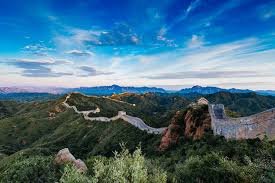The Myth and Majesty of the Great Wall
The Great Wall of China is not just a wall—it is a living legend, a serpentine structure winding across mountains, deserts, and grasslands like the spine of a mighty dragon. Stretching over 13,000 miles, it is the longest man-made structure in the world, a testament to human ambition and endurance. But beyond its staggering size, the Great Wall holds secrets, myths, and forgotten tales that most people have never heard.
One such legend claims that the wall was built with a mixture of sticky rice and mortar, making it stronger than many modern constructions. Archaeologists have indeed found traces of organic material in the ancient bricks, proving that this “secret ingredient” was real. Another lesser-known story tells of Meng Jiangnu, a woman whose tears supposedly caused a section of the wall to collapse after she learned of her husband’s death while laboring on its construction. These tales add a layer of mystique to an already awe-inspiring monument.
A Fortification Born from War and Strategy
The Great Wall was never a single continuous structure but a series of walls built by different dynasties over 2,000 years. Its earliest foundations date back to the 7th century BC, but the most famous sections were constructed during the Ming Dynasty (1368–1644 AD) to defend against Mongol invasions.
What many don’t realize is that the wall was not just a physical barrier—it was an advanced military network. Watchtowers, beacon stations, and garrison towns were strategically placed to send smoke signals across vast distances. A single fire at night or smoke column during the day could relay messages faster than any messenger on horseback. Some sections even had hidden trapdoors and ambush points to catch invaders off guard.

The Human Cost: Blood and Sweat Behind the Stones
The Great Wall is often called the “longest cemetery on Earth” because countless workers died during its construction. Historical records suggest that nearly one million laborers—convicts, peasants, and soldiers—perished from exhaustion, starvation, or harsh punishments. Their bodies were often buried within the wall itself, leading to eerie legends of restless spirits haunting its ramparts.
One chilling account tells of a section in Gansu Province where voices and wails are said to be heard at night. Locals believe these are the ghosts of workers who never left. Whether myth or reality, these stories remind us of the immense human sacrifice behind this architectural marvel.
Engineering Marvels and Hidden Passageways
The Great Wall of China construction techniques were revolutionary for their time. Builders used local materials—stone in the mountains, rammed earth in the plains—to adapt to different terrains. Some sections were reinforced with wooden planks, while others had drainage systems to prevent erosion.
One of the most fascinating hidden features is the “Secret Wall Passage” in Mutianyu, where a narrow, camouflaged path allowed soldiers to move undetected. Another surprising fact? The wall was not just for defense—it also controlled trade along the Silk Road, with customs checkpoints taxing merchants who passed through.

Great Wall of China That Was Never Seen from Space
A popular myth claims the Great Wall is the only man-made structure visible from space. In reality, astronauts confirm that it’s nearly impossible to see with the naked eye from low Earth orbit. The wall’s width and color blend into the natural landscape, debunking this long-held belief.
Another misconception is that the wall failed in its purpose. While it didn’t always stop invasions, it slowed enemies, giving Chinese forces time to mobilize. Genghis Khan, for instance, bypassed it entirely by bribing guards—a reminder that no wall is impenetrable.
The Great Wall of China Today: Preservation and Modern Adventures
Today, the Great Wall is a UNESCO World Heritage Site and a symbol of China’s cultural pride. However, erosion, tourism, and vandalism threaten its survival. Less than 10% of the original wall remains well-preserved, with many sections crumbling into ruins.
For adventurous travelers, remote areas like Jiankou offer rugged, unrestored paths with breathtaking views. Meanwhile, night tours at Badaling reveal the wall under moonlight, a surreal experience few get to witness. Whether you walk its ancient stones or uncover its hidden stories, the Great Wall remains one of humanity’s greatest achievements—a dragon forever etched into the earth.
Go to main page


